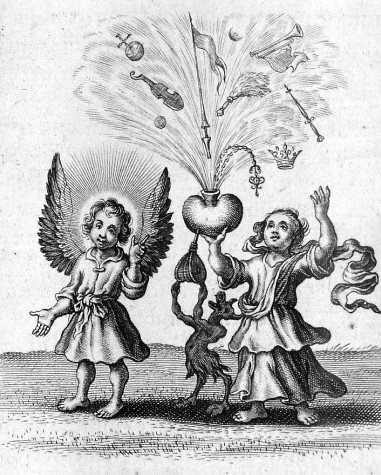1857 · (Modena
by MODENA FESTIVAL PROGRAM
(Modena: Tipografia della Regia-Ducal Camera), 1857. Small oblong folio (binding size 220 x 317 mm). Title printed in blue and gold within floral and foliate lithographic border in blue, with red wreaths and gold arrows at each corner; lithographic plate showing the grand facade of the Palazzo di Finanza within ornate floral and arabesque border with a putto at each lower corner, printed in red, green, and yellow, by the Litografia Goldoni in Modena; [4] pages text within ornamental page borders, printed entirely in blue. Contemporary cartonnage presentation(?) binding, both covers covered in blue watered silk within vermeil onlay borders stamped with a flower and leaf roll-tool, at center of front cover a large onlaid white glazed paper panel with design in gold and colored embossed appliqués: an outer frame containing stylized acanthus leaves in gray forming enclosed areas filled alternately with a pair of pink flowers and a pink & white striped ground, the frame enclosing an interlace border and centerpiece design in gold, a clump of red berries and green leaves at each side and at center a cluster of variously colored flowers (spine torn at foot, wear to corners and head of spine). ***
Only edition of a handsomely printed program, recording the emblematic decoration of the royal palace of finances in Modena (now the prefecture of police) for the occasion of the passage of Austro-Hungarian Emperor Franz-Josef I and his wife Empress Elizabeth through the town. Modena was simply a waystation between the imperial visits to Milan and Venice, but, possibly begrudgingly (four years before the finally successful Second Italian War of Independence), the city officials decked out this monumental building lining the main thoroughfare (Corso Canalgrande) in honor of the imperial passage. The decorations were made with “transparencies” of the kind used in the theater (scrim): cut-out gauze figures used to create visual effects when specially illuminated, appearing opaque when illuminated from the front and transparent when the light comes from behind.
The text identifies the 13 allegorical figures placed on the Palazzo’s facade and transcribes the epitaphs appearing elsewhere on the facade and on the two obelisks mounted at its outer edges. Winged allegorical figures of the houses of Austria and Este, unified by Bavaria, occupy the large central portico, and in each of the 12 flanking windows are figures representing religion, wisdom, justice, etc. The descriptions highlight details of light and color that testify to the meticulous effects of the transparencies (not visible on the simplified lithographic illustration). Gustavo Goldoni was the second lithographer of Modena; in 1840 he had purchased the press from his predecessor Giuseppe Gaddi.
Copies are found in plain wrappers. This special binding may have been intended for presentation.
Not in OCLC. ICCU ITICCUMOD1537994 (3 copies in Italy). Cf. P. Gaddi, “Intorno all’ arte della litografia in Modena,” Memorie della Regia Academia di Scienze, Lettere ed Arti di Modena, 1861, vol. 3, Sezione d’Arti, pp. 3-14. On trasparenti, cf. Enciclopedia dello Spettacolo (Rome, 1962) IX: 1095-6. (Inventory #: 4412)
Only edition of a handsomely printed program, recording the emblematic decoration of the royal palace of finances in Modena (now the prefecture of police) for the occasion of the passage of Austro-Hungarian Emperor Franz-Josef I and his wife Empress Elizabeth through the town. Modena was simply a waystation between the imperial visits to Milan and Venice, but, possibly begrudgingly (four years before the finally successful Second Italian War of Independence), the city officials decked out this monumental building lining the main thoroughfare (Corso Canalgrande) in honor of the imperial passage. The decorations were made with “transparencies” of the kind used in the theater (scrim): cut-out gauze figures used to create visual effects when specially illuminated, appearing opaque when illuminated from the front and transparent when the light comes from behind.
The text identifies the 13 allegorical figures placed on the Palazzo’s facade and transcribes the epitaphs appearing elsewhere on the facade and on the two obelisks mounted at its outer edges. Winged allegorical figures of the houses of Austria and Este, unified by Bavaria, occupy the large central portico, and in each of the 12 flanking windows are figures representing religion, wisdom, justice, etc. The descriptions highlight details of light and color that testify to the meticulous effects of the transparencies (not visible on the simplified lithographic illustration). Gustavo Goldoni was the second lithographer of Modena; in 1840 he had purchased the press from his predecessor Giuseppe Gaddi.
Copies are found in plain wrappers. This special binding may have been intended for presentation.
Not in OCLC. ICCU ITICCUMOD1537994 (3 copies in Italy). Cf. P. Gaddi, “Intorno all’ arte della litografia in Modena,” Memorie della Regia Academia di Scienze, Lettere ed Arti di Modena, 1861, vol. 3, Sezione d’Arti, pp. 3-14. On trasparenti, cf. Enciclopedia dello Spettacolo (Rome, 1962) IX: 1095-6. (Inventory #: 4412)







![[Timaeus]. De universitate sive de origine mundi libellus](https://d3525k1ryd2155.cloudfront.net/h/135/542/1665542135.0.m.jpg)
